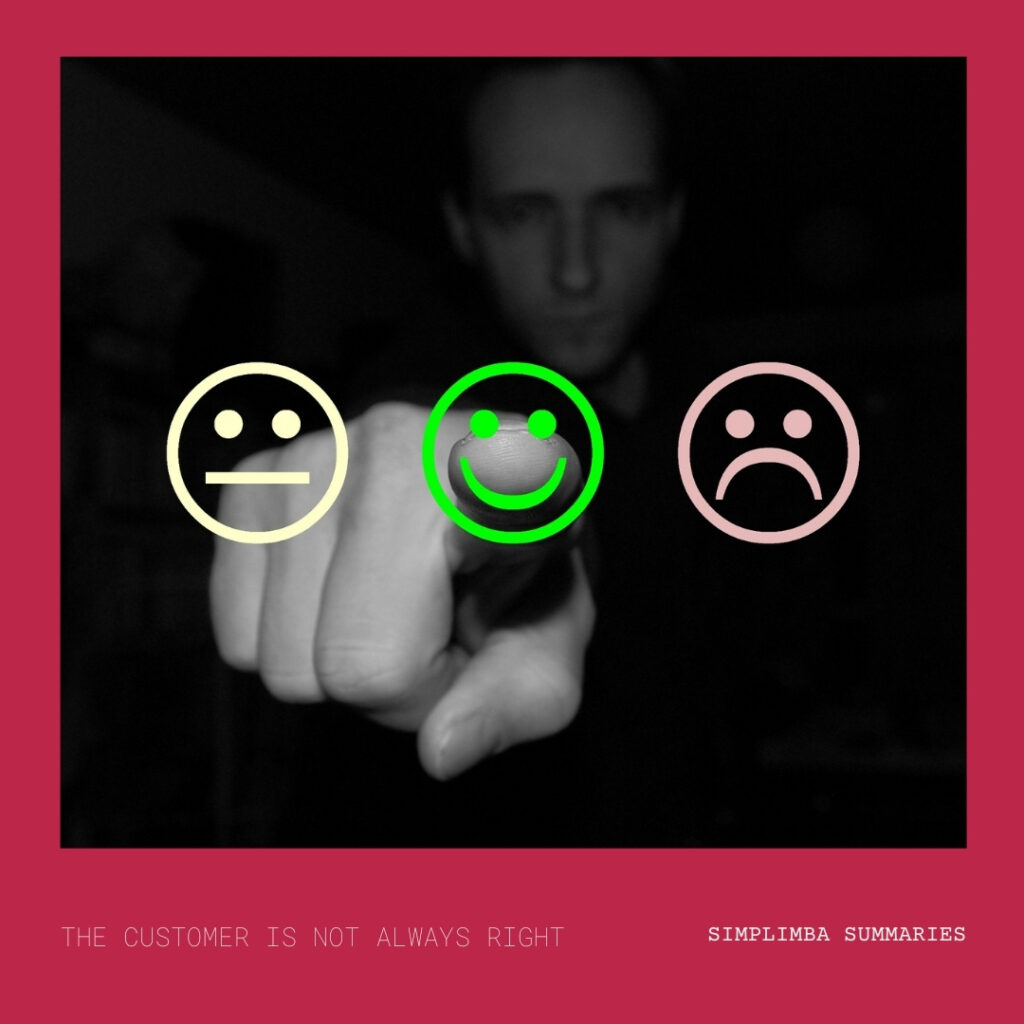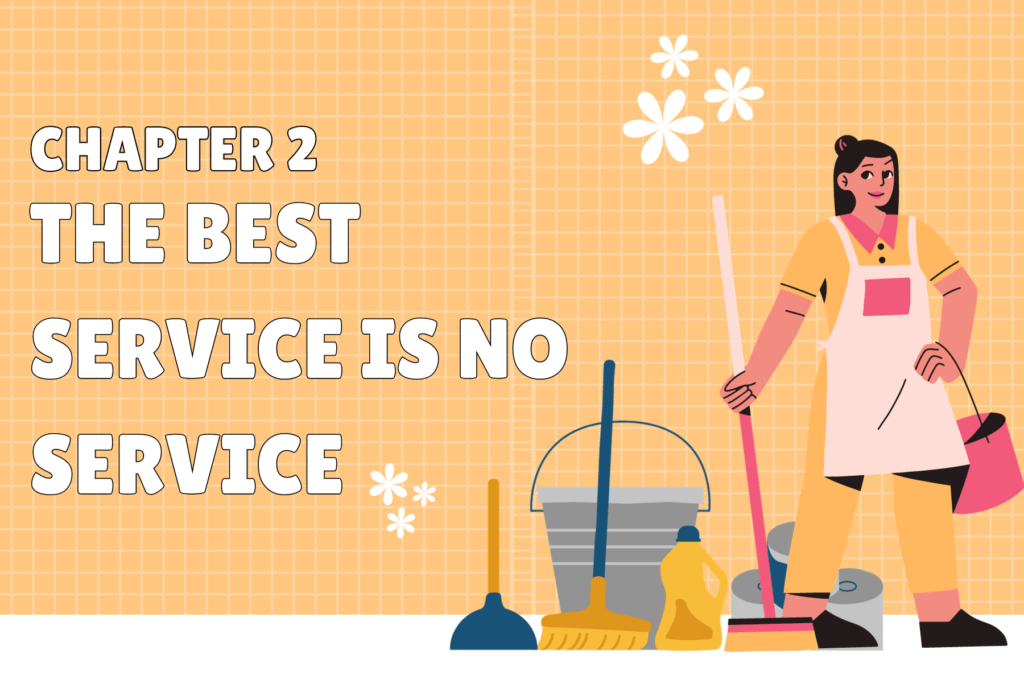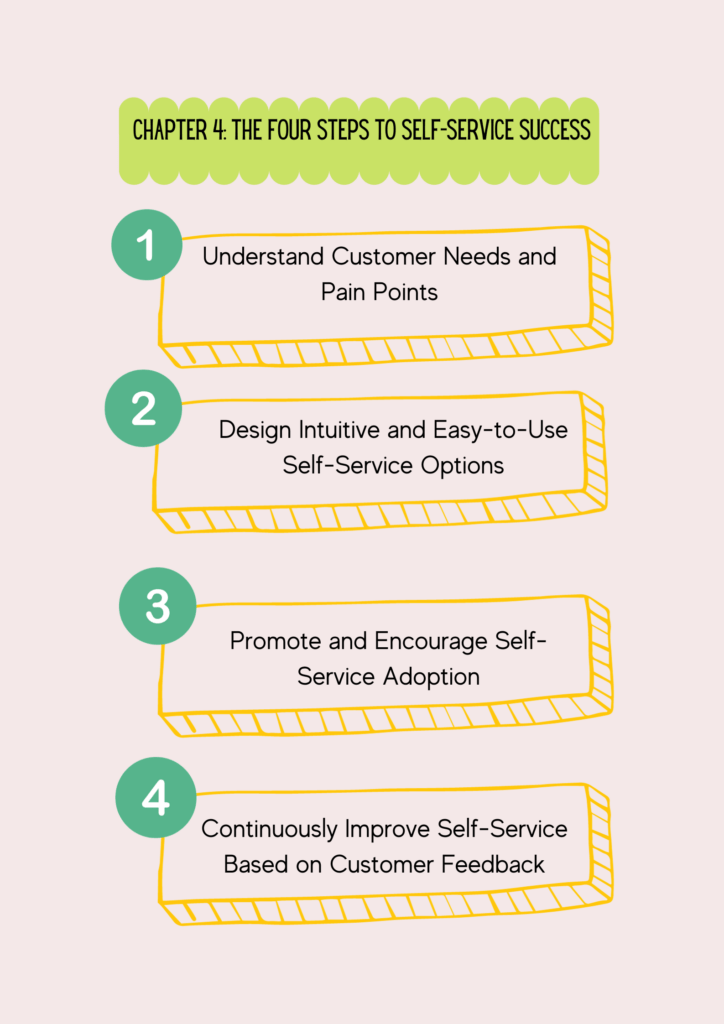The Best Service Is No Service: In the fast-paced world of business, customer service is often seen as a necessary evil. Companies invest significant resources into customer support teams, but customers still encounter frustrating experiences and long wait times. But what if there was a way to eliminate the need for customer service altogether? This is the central premise of “The Best Service Is No Service” by Bill Price and David Jaffe.
In this thought-provoking book, Price and Jaffe challenge the traditional notion that the customer is always right and argue that organizations should focus on delivering exceptional products and services that don’t require constant support. They introduce the concept of “no service,” which emphasizes the importance of preventing problems rather than simply resolving them. Through practical examples and real-world case studies, the authors provide a roadmap for organizations to achieve no service excellence and revolutionize the customer experience.
“The Best Service Is No Service” explores key principles such as designing for self-service, reducing customer effort, and being proactive in anticipating and addressing customer needs. Price and Jaffe highlight the benefits of adopting a no service mindset, including cost savings, increased customer satisfaction, and improved customer loyalty. With their authoritative yet engaging writing style, the authors provide actionable insights and strategies for organizations to implement in order to transform their customer service approach and deliver exceptional experiences.
Whether you’re a business owner, manager, or customer service professional, “The Best Service Is No Service” offers a fresh perspective on how to redefine customer service and create a customer-centric organization. It challenges conventional wisdom and provides practical advice that can be applied to any industry. By embracing the principles outlined in this book, organizations can not only save time and resources, but also build stronger relationships with their customers and stand out in today’s competitive market.
The Best Service is No Service: Chapter Wise Summary
Chapter 1: The Customer is Not Always Right

In the first chapter of “The Best Service Is No Service” by Bill Price and David Jaffe, the authors challenge the common belief that the customer is always right. They argue that organizations should aim to eliminate the need for customer service altogether, by delivering exceptional products and services that don’t require constant support. The authors emphasize the importance of focusing on preventing problems rather than simply resolving them, and provide examples of companies that have successfully adopted this mindset.
The authors assert, “The goal of a great service strategy should be to eliminate dumb contacts, not just resolve them efficiently“. They argue that organizations should invest in designing products and services that minimize the need for customer service interactions. This approach not only saves time and resources but also enhances the overall customer experience.
To support their argument, Price and Jaffe provide several examples of companies that have successfully adopted a no service mindset. One such example is Amazon, which built its business model around reducing customer effort. They quote Jeff Bezos, the founder of Amazon, who said, “The best customer service is if the customer doesn’t need to call you, doesn’t need to talk to you. It just works“. Amazon’s focus on delivering seamless and hassle-free experiences has earned them a loyal customer base.
Another example mentioned in the book is Intuit, the software company behind QuickBooks and TurboTax. Intuit realized that many customer service calls were related to simple user errors or lack of understanding. To address this, they invested in improving the usability and clarity of their products. As a result, they were able to significantly reduce the number of customer service interactions and enhance customer satisfaction.
Price and Jaffe also highlight the case of Commerce Bank, which adopted a proactive approach to customer service. Instead of waiting for customers to encounter issues, Commerce Bank identified potential problems and took preventive measures. They implemented measures such as proactively monitoring customer accounts for suspicious activity, saving customers the hassle of dealing with fraudulent transactions.
In this chapter, Price and Jaffe lay the foundation for the no service approach by challenging the notion that customer service should always be reactive. They emphasize the importance of understanding customer needs and designing products and services that address those needs proactively. By eliminating the need for customer service, organizations can create a more satisfying and efficient customer experience.
Chapter 2: The Best Service is No Service

In this chapter, Price and Jaffe explain the concept of “no service” and how it can revolutionize the customer experience. They highlight the fact that customers don’t want to contact customer service, they simply want their problems to be solved. The authors discuss the three key principles of no service: eliminate dumb contacts, create engaging self-service, and be proactive. They provide practical tips and strategies for implementing these principles in organizations.
One of the key points the authors make is that customers don’t actually want to contact customer service – they just want their problems to be solved. Price and Jaffe state, “Customers don’t want to talk to you, they just want their problems solved. The best service is no service – just give customers what they want“. This perspective shifts the focus from providing reactive customer service to proactively delivering exceptional products and services that don’t require constant support.
To illustrate the concept of “no service,” the authors provide several examples of companies that have successfully implemented this approach. One such example is Amazon, which has built a reputation for its seamless and hassle-free online shopping experience. Price and Jaffe explain, “Amazon has designed its service offerings to be so self-explanatory, efficient, and reliable that customer interactions are minimized, and customer issues are rare”. By prioritizing the elimination of customer service interactions, Amazon has been able to create a highly satisfying and efficient experience for its customers.
The authors also highlight the importance of preventing problems rather than simply resolving them. They argue that organizations should focus on “eliminating the root causes of problems, rather than just fixing the symptoms“. By addressing the underlying issues that lead to customer dissatisfaction, companies can reduce the need for customer service and improve the overall customer experience.
Price and Jaffe outline three key principles of no service: eliminate dumb contacts, create engaging self-service, and be proactive. They provide practical tips and strategies for implementing these principles in organizations. For example, they suggest using technology to automate routine tasks and enable self-service options, such as online FAQs and troubleshooting guides. They also emphasize the importance of being proactive in anticipating and addressing customer needs before they become problems.
Chapter 3: Designing for Self-Service
The authors delve into the importance of designing self-service options that are efficient, user-friendly, and meet customers’ needs. They explain that effective self-service reduces the need for customer contact and empowers customers to solve their own problems. Price and Jaffe provide examples of companies that have successfully implemented self-service solutions, and offer insights into how organizations can improve their own self-service offerings.
The authors begin by highlighting the significance of understanding customer needs and pain points when designing self-service options. They state, “To create self-service options that truly work, you need to understand your customers, anticipate their needs, and design solutions that solve their problems“. By gaining a deep understanding of customer preferences and pain points, organizations can tailor their self-service options to effectively address these needs.
Price and Jaffe further discuss the importance of simplicity and ease of use in self-service design. They mention, “The best self-service options are those that are easy to navigate, intuitive to use, and provide clear instructions or prompts to guide customers through the process“. Customers should be able to easily find the information they need and complete tasks without unnecessary complexity. The authors provide the example of Amazon’s self-service returns process, which allows customers to initiate and track returns online with minimal effort.
The authors also emphasize the significance of providing personalized self-service options. They state, “Personalization is key to delivering effective self-service. Customers want to feel that the solution they are using is tailored to their specific needs and preferences“. By offering personalized recommendations, suggestions, or solutions, organizations can enhance the customer experience and increase the likelihood of successful self-service interactions. Price and Jaffe mention the example of Netflix, which uses personalized recommendations to help customers discover new content based on their viewing history and preferences.
Additionally, Price and Jaffe discuss the importance of continuously improving self-service options based on customer feedback. They suggest that organizations should actively seek feedback from customers and use it to refine and enhance their self-service offerings. The authors state, “Feedback loops are essential for self-service success. They provide organizations with valuable insights into areas that need improvement and allow for continuous iteration and enhancement“. They provide the example of Apple, which regularly collects feedback from customers to improve its self-service support options.
Chapter 4: The Four Steps to Self-Service Success
In this chapter, Price and Jaffe outline the four steps to achieving self-service success. They emphasize the importance of understanding customer needs and pain points, designing intuitive and easy-to-use self-service options, promoting and encouraging self-service adoption, and continuously improving self-service based on customer feedback. The authors provide practical advice and real-world examples to help organizations implement these steps effectively.
Step 1: Understand Customer Needs and Pain Points
Price and Jaffe stress the importance of thoroughly understanding customer needs and pain points in order to design effective self-service options. They state, “You must have a deep understanding of your customers’ needs, and be able to anticipate their problems and questions before they even arise“.
One example mentioned in the book is Amazon’s customer-centric approach. By analyzing customer behavior and preferences, Amazon was able to develop features like “Customers Who Bought This Item Also Bought” and personalized recommendations, which significantly reduced the need for customer support.
Step 2: Design Intuitive and Easy-to-Use Self-Service Options
The authors highlight the need for self-service options that are intuitive, user-friendly, and easily accessible. They state, “If your self-service options are difficult to navigate or understand, customers will quickly become frustrated and abandon them, leading to unnecessary customer contact“.
An example provided in the book is Intuit’s TurboTax software. By simplifying the tax filing process and offering step-by-step guidance, Intuit made it easier for customers to complete their tax returns on their own, reducing the need for assistance from customer service representatives.
Step 3: Promote and Encourage Self-Service Adoption
Price and Jaffe emphasize the importance of promoting and encouraging customers to use self-service options. They mention, “You need to actively promote your self-service options and educate customers on how to use them effectively“.
An example highlighted in the book is USAA, a financial services company. USAA effectively promoted their self-service options through targeted marketing campaigns, educating customers on the benefits and ease of use. As a result, they saw a significant increase in self-service adoption and a decrease in customer contact.
Step 4: Continuously Improve Self-Service Based on Customer Feedback

The authors stress the need for organizations to continuously improve their self-service options based on customer feedback. They state, “Your self-service options should be dynamic and evolve based on customer needs and preferences“.
An example provided in the book is Netflix. By constantly gathering feedback from customers and analyzing their viewing habits, Netflix was able to improve their recommendation algorithm and personalize the user experience. This continuous improvement led to a decrease in customer inquiries and an increase in customer satisfaction.
By following these four steps, organizations can achieve self-service success and significantly reduce the need for customer contact. Price and Jaffe emphasize the importance of a customer-centric approach, continuous improvement, and ease of use in designing effective self-service options.
Chapter 5: Reducing Customer Effort

Price and Jaffe explore the concept of customer effort and its impact on the overall customer experience. They argue that reducing customer effort should be a top priority for organizations, as it leads to increased customer satisfaction and loyalty. The authors discuss strategies for reducing customer effort, such as simplifying processes, improving communication, and providing clear and concise information. They also highlight the importance of empowering frontline employees to solve customer problems without unnecessary effort.
The authors start by emphasizing that reducing customer effort should be a top priority for organizations. They state, “Every bit of effort we put on our customers has a price – their time, their loyalty, and ultimately, their money“. This quote highlights the negative consequences of burdening customers with unnecessary effort, as it can lead to frustration, dissatisfaction, and even loss of business.
To illustrate the importance of reducing customer effort, Price and Jaffe provide several examples of companies that have successfully implemented strategies to minimize customer effort. One such example is Amazon’s “one-click” ordering system. By simplifying the purchasing process to just a single click, Amazon has significantly reduced the effort required from customers, resulting in increased sales and customer satisfaction.
The authors also discuss the need for organizations to improve communication and provide clear and concise information to customers. They mention the example of USAA, an insurance company that proactively communicates with customers during the claims process. By keeping customers informed and reducing uncertainty, USAA reduces customer effort and enhances the overall experience.
Another strategy mentioned by Price and Jaffe is the use of self-service options to reduce customer effort. They cite the example of Intuit, the company behind QuickBooks, which provides a comprehensive self-help portal for customers to find answers to their questions. By empowering customers to solve their own problems, Intuit reduces the need for customer contact and streamlines the support process.
The authors also highlight the importance of empowering frontline employees to solve customer problems without unnecessary effort. They mention the example of Nordstrom, a renowned retail company known for its exceptional customer service. Nordstrom empowers its employees to make decisions and take action to resolve customer issues, minimizing the effort required from customers and creating a positive experience.
Throughout the chapter, Price and Jaffe provide practical advice on how organizations can reduce customer effort. They stress the need for simplicity, clarity, and efficiency in processes, communication, and self-service options. By implementing these strategies, organizations can significantly enhance the customer experience and build long-term loyalty.
Chapter 6: Proactive Service
In this chapter, Price and Jaffe emphasize the importance of being proactive in customer service. They explain that proactive service involves anticipating customer needs and addressing them before they become problems. The authors provide examples of companies that have successfully implemented proactive service strategies, and offer practical tips for organizations to adopt this approach. They also discuss the benefits of proactive service, such as increased customer loyalty and reduced customer effort.
Price and Jaffe begin the chapter by stating, “Proactive service involves predicting customer needs and desires and addressing them before they even arise“. They highlight the fact that customers appreciate when companies take the initiative to solve their problems without them having to reach out for assistance.
To illustrate the power of proactive service, the authors provide the example of Amazon. They explain how Amazon’s use of data analytics and personalized recommendations helps them anticipate customer needs and make relevant suggestions. This not only saves customers time and effort in searching for products, but also enhances their overall shopping experience.
Price and Jaffe also discuss the importance of effective communication in proactive service. They state, “Proactive communication means reaching out to customers before they reach out to you“. By providing timely updates, relevant information, and proactive solutions, organizations can prevent potential problems and ensure customer satisfaction.
To support their point, the authors share the example of Zappos, an online shoe retailer known for its exceptional customer service. Zappos proactively communicates with customers by sending order and shipping updates, providing tracking information, and even reaching out to customers to suggest alternative products if an item is out of stock. This proactive approach not only saves customers from having to contact customer service for updates, but also builds trust and loyalty.
Price and Jaffe further discuss the benefits of proactive service, including increased customer loyalty and reduced customer effort. They state, “When customers don’t have to reach out to you for help, they are more likely to remain loyal to your brand“. By taking the initiative to address customer needs, organizations can strengthen their relationships and create a positive impression.
The authors also highlight the role of technology in enabling proactive service. They mention how companies can leverage artificial intelligence, chatbots, and automated systems to anticipate customer needs and provide proactive solutions. However, they caution against relying solely on technology and emphasize the importance of human touch and empathy in delivering exceptional proactive service.
Chapter 7: The ROI of No Service
Price and Jaffe discuss the return on investment (ROI) of implementing a no service strategy. They explain that by focusing on prevention rather than resolution, organizations can save time, money, and resources. The authors provide examples of companies that have achieved significant cost savings through no service initiatives, and offer guidance on how organizations can measure the ROI of their own efforts. They also highlight the long-term benefits of no service, such as improved customer satisfaction and loyalty.
Price and Jaffe begin by highlighting the cost of traditional customer service. They explain that resolving customer issues can be time-consuming and expensive, often requiring the involvement of multiple employees and resources. The authors state, “Every time a customer contacts you, it’s a failure. It means something went wrong, and you have to spend time and money to fix it“.
To illustrate the potential savings of a no service strategy, the authors share the example of Commerce Bank, a successful regional bank in the United States. Commerce Bank focused on reducing the need for customer service by providing customers with transparent and hassle-free banking experiences. As a result, they were able to achieve cost savings of over $200 million annually, primarily by eliminating the need for call center support.
Price and Jaffe also discuss the concept of customer loyalty and its impact on ROI. They argue that by delivering exceptional products and services that don’t require constant support, organizations can cultivate loyal customers who are more likely to stay with the company and recommend it to others. The authors state, “Loyal customers are more valuable to a company than new customers, and they are also more cost-effective to serve“.
To support this argument, the authors provide the example of USAA, a financial services company serving military personnel and their families. USAA focuses on providing outstanding self-service options and proactive support, resulting in high customer loyalty and retention rates. Price and Jaffe explain that USAA’s loyal customers generate significantly more revenue than their non-loyal counterparts, showcasing the financial benefits of a no service approach.
Furthermore, the authors emphasize the long-term benefits of no service. They explain that by delivering exceptional products and services, organizations can differentiate themselves from competitors and build a strong brand reputation. This, in turn, leads to increased customer trust and loyalty. Price and Jaffe state, “A company that delivers great products and services that require no customer contact will stand out from the competition and build a reputation as a trustworthy, reliable brand“.
To illustrate this point, the authors highlight the success of Apple. Apple’s focus on designing intuitive and user-friendly products has minimized the need for customer support, leading to a strong brand reputation and a dedicated customer base. Price and Jaffe explain that Apple’s customers are willing to pay a premium for their products because they trust the brand and know they will have a seamless experience.
Chapter 8: The No Service Manifesto
In the final chapter of the book, Price and Jaffe present the “No Service Manifesto.” They summarize the key principles and strategies discussed throughout the book, and provide a roadmap for organizations to follow in order to achieve no service excellence. The authors emphasize the importance of a customer-centric approach, continuous improvement, and a proactive mindset. They conclude by highlighting the potential for organizations to differentiate themselves through exceptional products and services that require minimal customer service.
The authors begin by emphasizing the importance of a customer-centric approach. They state, “Customer satisfaction should be the ultimate goal of every organization, and no service is the path to achieving it“. They highlight the need for organizations to understand and meet customer needs in order to eliminate the need for service.
To illustrate this point, Price and Jaffe provide the example of Amazon. They explain how Amazon has focused on delivering exceptional products and services, such as their one-click ordering and fast shipping, which have significantly reduced the need for customer service. By prioritizing the customer experience and ensuring that the product or service meets or exceeds customer expectations, organizations can minimize the need for customer service interactions.
The authors then discuss the importance of continuous improvement in the pursuit of no service excellence. They state, “No service is a journey, not a destination“. They emphasize the need for organizations to constantly evaluate and improve their processes, systems, and self-service options in order to prevent problems and enhance the customer experience.
To illustrate this point, Price and Jaffe provide the example of Zappos. They explain how Zappos encourages its employees to constantly seek ways to improve the customer experience, even if it means going above and beyond their typical roles. By fostering a culture of continuous improvement and empowering employees to take ownership of the customer experience, organizations can proactively address customer needs and prevent issues from arising.
The authors also highlight the importance of a proactive mindset in achieving no service excellence. They state, “Proactive service is about anticipating customer needs and addressing them before they become problems“. They emphasize the need for organizations to be proactive in identifying potential pain points and taking preemptive action to resolve them.
To illustrate this point, Price and Jaffe provide the example of Apple. They explain how Apple’s Genius Bar concept allows customers to schedule appointments with knowledgeable staff who can help address any issues or questions they may have. By proactively providing resources and support to customers, Apple reduces the need for customers to seek assistance through traditional customer service channels
Samrat is a Delhi-based MBA from the Indian Institute of Management. He is a Strategy, AI, and Marketing Enthusiast and passionately writes about core and emerging topics in Management studies. Reach out to his LinkedIn for a discussion or follow his Quora Page

